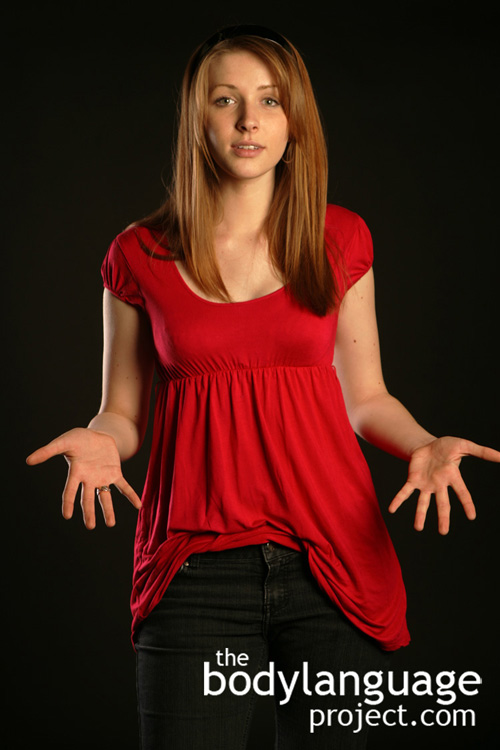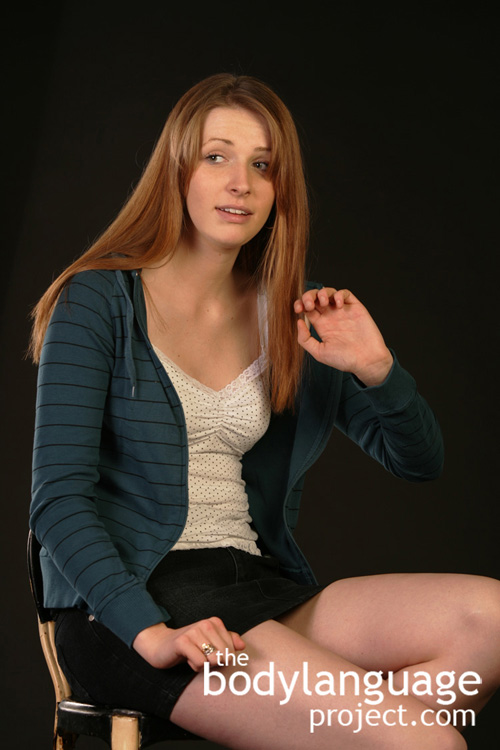Body Language of Finger Spreading
Synonym(s): Finger Spreader (The)
Description: The hands are held out and fingers splayed apart facing palm to the audience.
In One Sentence: Spreading the fingers is a way to capture the attention of other people like a large embrace.
How To Use it: Spread the fingers out when trying to connect with a wide audience. Use the posture to show others that you are confident and willing to embrace them fully and have the dominance to put yourself out on full display. This posture is best used during presentations to a large audience.
Context: General.
Verbal Translation: “I’m spreading my fingers and extending my arms to try to touch and feel each one of you, connect with you, and massage my ideas into your minds.”
Variant: See Baton Gesture, Finger Pointing.
Cue In Action: The presenter spreads his fingers and extends his arms as he tries to explain his concept. His desire to connect demonstrates authority, confidence, dominance and enthusiasm.
Meaning and/or Motivation: This is an attempt to make contact with the entire audience.
Cue Cluster: N/A
Body Language Category: Authoritative body language, Confident body language, Dominant body language, Enthusiasm (nonverbal), Expansive movements, Excited, Gravity defying body language, High confidence body language, Leadership body language, Open body language, Palm power, Rapport or rapport building, Remotivating.
Resources:
Adams, E.S., Mesterton-Gibbons, M., 1995. The cost of threat displays and the stability of deceptive communication. J. Theor. Biol. 175, 405–421.
Alibali, M.W., Heath, D.C., and Myers,H.J. (2001). Effects of visibility between speaker and listener on gesture production: Some gestures are meant to be seen. Journal of Memory and Language, 44, 169–188.
Allen, Jill; Sarah J. Gervais and Jessi L. Smith. Sit Big to Eat Big: The Interaction of Body Posture and Body Concern on Restrained Eating. Psychology of Women Quarterly 2013. 37(3): 325-336. DOI: 10.1177/0361684313476477pwq.sagepub.com
http://bodylanguageproject.com/articles/sit-big-to-eat-big-how-constrictive-postures-reduce-food-consumption/
Arnette, S. L., & Pettijohn, T. F., II. (2012). The effects of posture on self-perceived leadership. International Journal of Business and Social Science, 3, 8–13.
Bohns, Vanessa K. and Scott S. Wiltermuth. It Hurts When I Do This (Or You Do That): Posture And Pain tolerance. Journal of Experimental Social Psychology. 2012. 48: 341-345.
http://bodylanguageproject.com/articles/dominant-and-submissive-postures-affects-more-than-public-perception-it-also-affects-felt-pain-and-physical-strength/
Briñol, P., Petty, R. E., & Wagner, B. (2009). Body posture effects on self-evaluation: A self-validation approach. European Journal of Social Psychology, 39, 1053–1064.
Beattie, G., & Shovelton,H.(1999). Mapping the range of information contained in the iconich and gestures that accompany spontaneous speech. Journal of Language and social Psychology, 18, 438–462.
Biau, E., & Soto-Faraco, S.(2013). Beat gestures modulate auditory integration in speech perception. Brain and Language, 124(2), 143–152.
Burgoon, J. K., Johnson, M. L., & Koch, P. T. (1998). The nature and measurement of interpersonal dominance. Communication Monographs, 65, 308–335.
Balzarotti, Stefania ; Piccini, Luca ; Andreoni, Giuseppe ; Ciceri, Rita “I Know That You Know How I Feel”: Behavioral and Physiological Signals Demonstrate Emotional Attunement While Interacting with a Computer Simulating Emotional Intelligence. Journal of Nonverbal Behavior. 2014. 38(3): 283-299.
Bernstein, Constance. Winning trials nonverbally: six ways to establish control in the courtroom. Trial. 1994. 30(1).61(5)
Brownell, Judi. Communicating with credibility: The gender gap. Cornell Hotel and Restaurant Administration Quarterly. 1993. 34(2): 52-61.
Bass, Andrew & Boris P. Chagnaud. 2013. Shared developmental and evolutionary origins for neural basis of vocal–acoustic and pectoral–gestural signaling. Proceedings of the National Academy of Sciences.
Birdwhistell, Ray. 1952. An introduction to kinesics. Louisville: University of Louisville.
Birdwhistell, Ray. 1970. Kinesics and context. Philadelphia: University of Pennsylvania.
Cashdan, Elizabeth. Smiles, Speech, and Body Posture: How Women and Men Display Sociometric Status and Power. Journal of Nonverbal Behavior. 1998. 22(4): 209-228.
Cuddy, Amy J.C. ; Glick, Peter ; Beninger, Anna. The dynamics of warmth and competence judgments, and their outcomes in organizations. Research in Organizational Behavior. 2011. 31: 73-98.
Carney, D. R., Hall, J. A., & LeBeau, L. S. (2005). Beliefs about the nonverbal expression of social power. Journal of Nonverbal Behavior, 29, 105–123.
Carney, Dana R.; Amy J.C. Cuddy; Andy J. Yap. Power Posing: Brief Nonverbal Displays Affect Neuroendocrine Levels and Risk Tolerance. Psychological Science, 2010; 21 (10): 1363-1368.
http://bodylanguageproject.com/articles/benefits-power-posing-high-stakes-performance/
Cesario, J., & McDonald, M. M. (2013). Bodies in context: Power poses as a computation of action possibility. Social Cognition, 31, 260–274.
Cuddy, Amy J.C., Caroline A. Wilmuth, and Dana R. Carney. The Benefit of Power Posing Before a High-Stakes Social Evaluation. Harvard Business School Working Paper, No. 13-027, September 2012.
http://bodylanguageproject.com/articles/benefits-power-posing-high-stakes-performance/
Edinger, Joyce A. ; Patterson, Miles L. Zeaman, David (editor). Nonverbal involvement and social control. Psychological Bulletin. 1983. 93(1): 30-56.
Ekman, Paul, and Wallace V. Friesen (1969). “Nonverbal Leakage and Clues to Deception.” In Psychiatry (Vol. 32), pp. 88-106.
Ekman, Paul & Wallace V. Friesen. 1972. Hand movements. Journal of Communication. Vol. 22, Dec. 1, pp. 353-374.
Engel, George. 1978. Clinical value of gestures, postures, and facial expressions. Public lecture. University of Washington. Seattle. December 5.
Fabrega, Horatio Jr. 1973. Begging in a southeastern Mexican city.” In Romney, A. K. & I. DeVore (eds.). You and others. Cambridge, Mass.: Winthrop, pp. 162-173.
Friesen, Wallace ; Ekman, Paul ; Wallbott, Harald. Measuring hand movements. Journal of Nonverbal Behavior. 1979. 4(2): 97-112.
Fatt, James P. T. It’s not what you say, it’s how you say it.(nonverbal communication). Communication World. 1999. 16(6): 37(4).
Fischer, Julia; Peter Fischer; Birte Englich; Nilüfer Aydin and Dieter Frey. Empower My Decisions: The Effects of Power Gestures on Confirmatory Information Processing. Journal of Experimental Social Psychology. 2011. 47: 1146-1154.
http://bodylanguageproject.com/articles/downside-power-posing-body-language-looking-power-posing-action-study/
http://bodylanguageproject.com/articles/benefits-power-posing-high-stakes-performance/
Goffman, Erving. The Nature of Deference and Demeanor. American Anthropologist. 1956. 58(3): 473-502.
Givens, David B. (1982). “From Here to Eternity: Communicating With the Distant Future.” In Et Cetera (Vol. 39, No. 2), pp. 159-79.
Givens, David B. (forthcoming). “Reading Palm-up Signs: Neurosemiotic Overview of a Common Hand Gesture” (Accepted for publication [March 4, 2015] in Semiotica).
Givens, David B. 1977. Shoulder shrugging: A densely communicative expressive behavior. Semiotica. Vol. 19:1/2, pp. 13-28.
Givens, David B. 1982. An ethological approach to the study of human nonverbal communication. Ann Arbor: University Microfilms.
Givens, David B. 1986. The big and the small: Toward a paleontology of gesture. Sign Language Studies. No. 51. Summer, pp. 145-167.
Givens, David B. 2005. Love signals: A practical field guide to the body language of courtship. New York: St. Martin’s Press.
Givens, David B. 2014b. Nonverbal neurology: How the brain encodes and decodes wordless signs, signals, and cues. In Kostic, Aleksandra & Derek Chadee (eds.). Social psychology of nonverbal communication. New York: Palgrave-MacMillan Press, pp. 9-30.
Givens, David B. 2014c. Measuring gestures. In Kostic, Aleksandra & Derek Chadee (eds.). Social psychology of nonverbal communication. New York: Palgrave-MacMillan Press, pp. 66-91.
Goffman, Erving. 1956. The nature of deference and demeanor. American Anthropologist. Vol. 58, No, 3, June, pp. 473-502.
Goodall, Jane. 1986. The chimpanzees of gombe: Patterns of behavior. Cambridge: Belknap Press of Harvard University.
Hall, Karl & Irven DeVore. 1972. Baboon social behavior. In Phyllis Dolhinow (ed.). Primate patterns. San Francisco: Holt, Rinehart, and Winston, pp. 125-180.
Holle, H., & Gunter,T.C. (2007). The role of iconic gestures in speech disambiguation: ERP evidence. Journal of Cognitive Neuroscience, 19, 1175–1192.
Holler, J., Shovelton, H.,& Beattie, G.(2009).Do iconic hand gestures really contribute to the communication of semantic information in a face-to-face context? Journal of Nonverbal Behavior, 33, 73–88.
Hubbard, A.L., Wilson, S. M., Callan, D. E., & Dapretto, M.(2009).Giving speech a hand: Gesture modulates activity in auditory cortex during speech perception. Human Brain Mapping, 30, 1028–1037.
Huang, L., Galinsky, A. D., Gruenfeld, D. H., & Guillory, L. E. (2011). Powerful postures versus powerful roles: Which is the proximate correlate of thought and behavior? Psychological Science, 22, 95–102.
Hubbard, Amy, McNealy, K., Zeeland, A., Callan, D. & M. Dapretto. 2012. Altered integration of speech and gesture in children with autism spectrum disorders. Brain and Behavior. Vol. 2, No. 5, Sept. 2012, pp. 606-619.
Iacoboni, Marco. 2009. Imitation, empathy, and mirror neurons. Annual Review of Psychology. Vol. 60, pp. 653-670.
Kendon, Adam. 2004. Gesture: Visible actions as utterance. Cambrideg: Cambridge University Press.
Kelly, S. D., Barr, D. J., Church, R. B., & Lynch, K.(1999).Offering a hand topragmatic understanding: The role of speech and gesture in comprehension and memory. Journal of Memory and Language, 40, 577–592.
Kelly, S. D., Creigh, P., & Bartolotti, J.(2009).Integrating speech and iconic gestures in a Stroop-like task: Evidence for automatic processing. Journal of Cognitive Neuroscience, 22, 683–694.
Kelly, S.D., Kravitz, C.,& Hopkins, M.(2004).Neural correlates of bimodal speech and gesture comprehension. Brain and Language, 89(1), 253–260.
Krahmer,E., & Swerts, M.(2007).The effects of visual beats on prosodic prominence: Acoustic analyses, auditory perception and visual perception. Journal of Memory and Language, 57, 396–414.
Krauss, R. M., Dushay, R.A., Chen,Y., & Rauscher, F.(1995).The communicative value of conversational hand gesture. Journal of Experimental Social Psychology, 31(6), 533–552.
Koppensteiner, Markus ; Grammer, Karl. Body movements of male and female speakers and their influence on perceptions of personality. Personality and Individual Differences. 2011. 51(6): 743-747.
Koppensteiner, Markus ; Stephan, Pia ; Jäschke, Johannes Paul Michael. From body motion to cheers: Speakers’ body movements as predictors of applause. Personality and Individual Differences. 2015. 74: 182-185.
Leigh, Thomas W. ; Summers, John O. An initial evaluation of industrial buyers’ impressions of salespersons’ nonverbal cues. Journal of Personal Selling & Sales Management. 2002. 22(1): 41(13).
Leonard, T., & Cummins, F.(2010).The temporal relation between beat gestures and speech. Language and Cognitive Processes, 26, 1457–1471.
Marler, Peter. 1965. Communication in monkeys and apes. In DeVore, I. (ed.), Primate behavior. New York: Holt, Rinehart & Winston, pp. 544-584.
McNeill, David. 1992. Hand and mind: What gestures reveal about thought. Chicago: University of Chicago Press.
McNeill, David. 2005. Gesture and thought. Chicago: University of Chicago Press.
Mittelberg, Irene. 2008. Peircean semiotics meets conceptual metaphor: Iconic modes in gestural representations of grammar. In Cienki, A. & C. Müller (eds.). Metaphor and gesture. Amsterdam/Philadelphia: John Benjamins, pp. 115-154.
Montgomery, Kimberly J., Isenberg, Nancy & James V. Haxby. 2007. Communicative hand gestures and object-directed hand movements activated the mirror neuron system. Social Cognitive and Affective Neuroscience. Vol. 2, No. 2, June, pp. 114-122.
Muller, C. 2004. Forms and uses of the palm up open hand: A case of gesture family?” In Muller, C. & Ronald Posner (eds.). The semantics and pragmatics of everyday gestures. Berlin: Weidler, pp. 233-356.
Lee, E. H., & Schnall, S. (2014). The influence of social power on weight perception. Journal of Experimental Psychology: General, 143, 1719–1725.
Michalak, J., Mischnat, J., & Teismann, T. (2014). Sitting posture makes a difference: Embodiment effects on depressive memory bias. Clinical Psychology & Psychotherapy, 21, 519–524.
Minvaleev, R. S., Nozdrachev, A. D., Kir’yanova, V. V., & Ivanov, A. I. (2004). Postural influences on the hormone level in healthy subjects: I. The cobra posture and steroid hormones. Human Physiology, 30, 452–456.
Morris, Desmond (1994). Bodytalk: The Meaning of Human Gestures (New York: Crown Publishers).
Meier, B. P., & Robinson, M. D. (2005). The metaphorical representation of affect. Metaphor and Symbol, 21, 239–257.
Meier, B.P., Robinson, M.D., & Caven, A.J. (in press). Why a big mac is a good mac: Associations between affect and size. Basic and Applied Social Psychology.
Mehrabian, Albert Holzberg, Jules D. (editor). Inference of Attitudes From the Posture, Orientation and Distance of a Communicator. Journal of Consulting and Clinical Psychology. 1968. 32(3): 296-308.
Mehrabian, Albert Deese, James (editor). Significance of posture and position in the communication of attitude and status relationships. Psychological Bulletin. 1969. 71(5): 359-372.
Mehrabian, Albert ; Williams, Martin Mcguire, William J. (editor). Nonverbal concomitants of perceived and intended persuasiveness. Journal of Personality and Social Psychology. 1969. 13(1): 37-58.
Matsumoto, D., & Willingham, B. (2006). The thrill of victory and the agony of defeat: Spontaneous expressions of medal winners of the 2004 Athens Olympic Games. Journal of Personality and Social Psychology, 91(3), 568–581.
Nair, S., Sagar, M., Sollers, J., III, Consedine, N., & Broadbent, E. (2014). Do slumped and upright postures affect stress responses? A randomized trial. Health Psychology. Advance online publication. doi:10.1037/hea0000146
Park, Lora E.; Lindsey Streamer; Li Huang and Adam D. Galinsky. Stand Tall, But Don’t Put Your Feet Up: Universal and Culturally-Specific Effects of Expansive Postures On Power. Journal of Experimental Social Psychology. 2013; 49: 965–971.
http://bodylanguageproject.com/articles/are-expansive-postures-of-power-universal-or-cultural/
Rekers, G A ; Rudy, J P. Differentiation of childhood body gestures. Perceptual and motor skills. 1978. 46(3 Pt 1): 839-45.
Roll, William V. ; Schmidt, Lyle D. ; Kaul, Theodore J. Berdie, Ralph F. (editor). Perceived interviewer trustworthiness among black and white convicts. Journal of Counseling Psychology. 1972. 19(6): 537-541.
Ryan, Mary E. Good nonverbal communication skills can reduce stress. (Law Office Management). Trial. 1995. 31(1): 70(5).
Ranehill, Eva; Anna Dreber; Magnus Johannesson; Susanne Leiberg; Sunhae Sul and Roberto A. Weber. Assessing the Robustness of Power Posing: No Effect on Hormones and Risk Tolerance in a Large Sample of Men and Women. Psychological Science, March, 2015. doi: 10.1177/0956797614553946 http://bodylanguageproject.com/articles/power-posing-no-effect-hormones-amy-cuddy-wrong/
Riskind, J. H. (1984). They stoop to conquer: Guiding and selfregulatory functions of physical posture after success and failure. Journal of Personality and Social Psychology, 47, 479–493.
Riskind, J. H., & Gotay, C. C. (1982). Physical posture: Could it have regulatory or feedback effects on motivation and emotion? Motivation and Emotion, 6, 273–298.
Stepper, S., & Strack, F. (1993). Proprioceptive determinants of emotional and nonemotional feelings. Journal of Personality and Social Psychology, 64, 211–220.
Strelan, P., Weick, M., & Vasiljevic, M. (2013). Power and revenge. British Journal of Social Psychology, 53, 521–540.
Schwartz, B., Tesser, A., & Powell, E. (1982). Dominance cues in nonverbal behavior. Social Psychology Quarterly, 45, 114–120.
Sun Jung, Hyo Sun and Hye Hyun Yoon. The Effects of Nonverbal Communication of Employees in the Family Restaurant Upon Customers’ Emotional Responses and Customer Satisfaction. International Journal of Hospitality Management. 2011. 30: 542-550.
http://bodylanguageproject.com/articles/effect-body-languagel-cues-family-restaurant/
Tiedens, Larissa Z. and Alison R. Fragale. Power Moves: Complementarity in Dominant and Submissive Nonverbal Behavior. Journal of Personality and Social Psychology. 2003, 84(3): 558–568.
http://bodylanguageproject.com/articles/power-posing-no-effect-hormones-amy-cuddy-wrong/
Tracy, J. L., & Robins, R. W. (2004). Show your pride: Evidence for a discrete emotion expression. Psychological Science, 15, 194–197.
Yuksel, Atila. Nonverbal Service Behavior and Customer’s Affective Assessment. Journal of Quality Assurance in Hospitality & Tourism. 2008. 9(1): 57-77.
Welker, K. M., Oberleitner, D. E., Cain, S., & Carré, J. M. (2013). Upright and left out: Posture moderates the effects of social exclusion on mood and threats to basic needs. European Journal of Social Psychology, 43, 355–361.
Wu, Y. C., & Coulson, S.(2005).Meaningful gestures: Electrophysiological indices of iconic gesture comprehension. Psychophysiology, 42, 654–667.
Waal, Frans De (1982). Chimpanzee Politics (London: Jonathan Cape).
Wang, Lin ; Chu, Mingyuan Neuropsychologia. The role of beat gesture and pitch accent in semantic processing: An ERP study. 2013, Vol.51(13), pp.2847-2855
Xu, Jiang, Gannon, Patrick J., Emmorey, Karen, Smith, Jason F. & Allen R. Braun. 2009. Symbolic gestures and spoken language are processed by a common neural system. Proceedings of the National Academy of Sciences.
Yap, Andy J. Abbie S. Wazlawek, Brian J. Lucas, Amy J. C. Cuddy, Dana R. Carney. The Ergonomics of Dishonesty: The Effect of Incidental Posture on Stealing, Cheating, and Traffic Violations, 24(11); 2281-2289.
http://bodylanguageproject.com/articles/body-posture-physical-environment-determine-feelings-and-behaviour-study/



